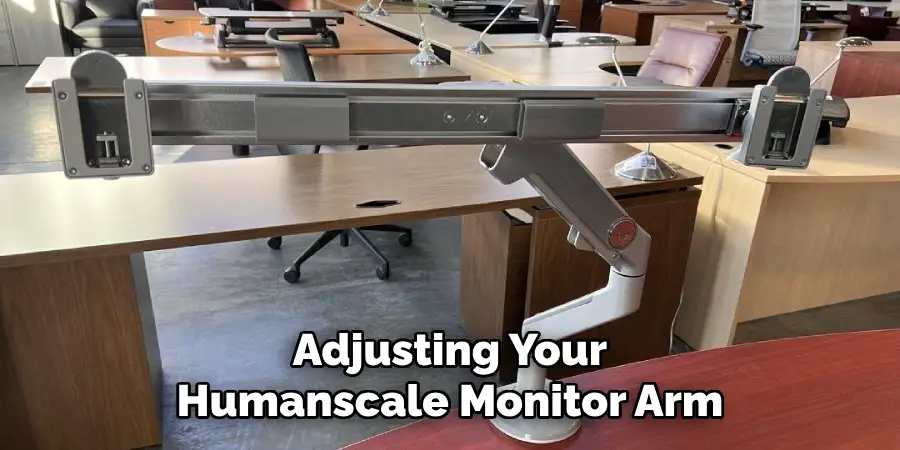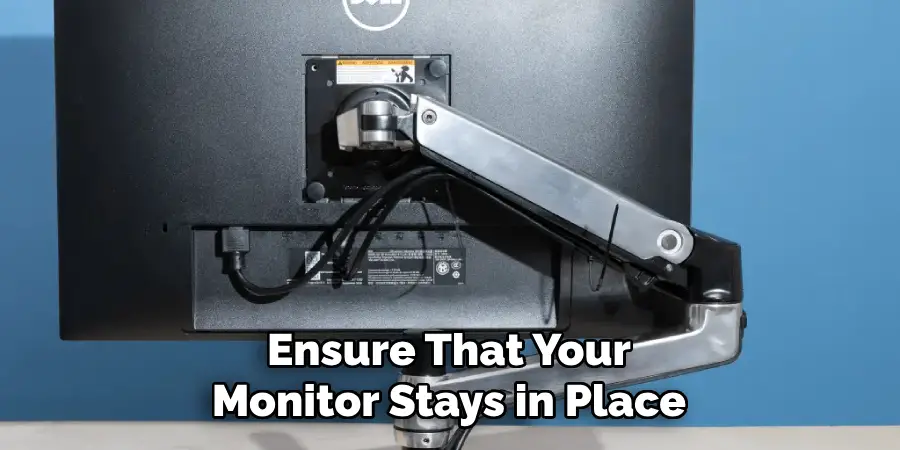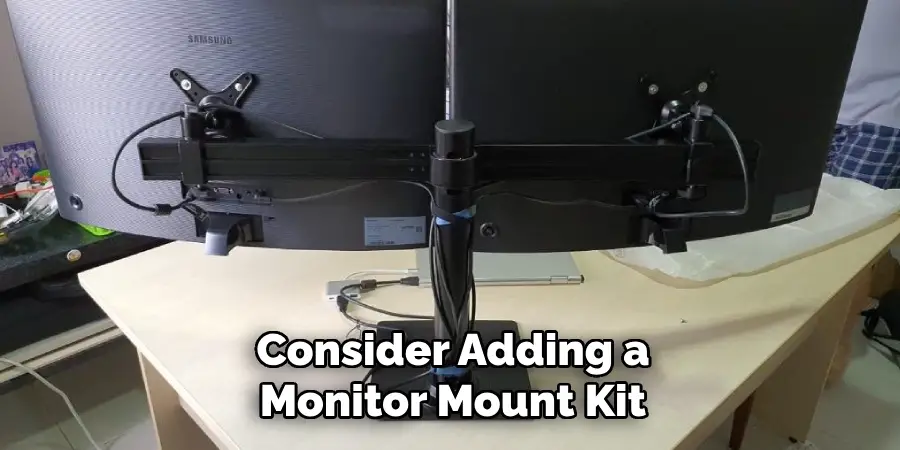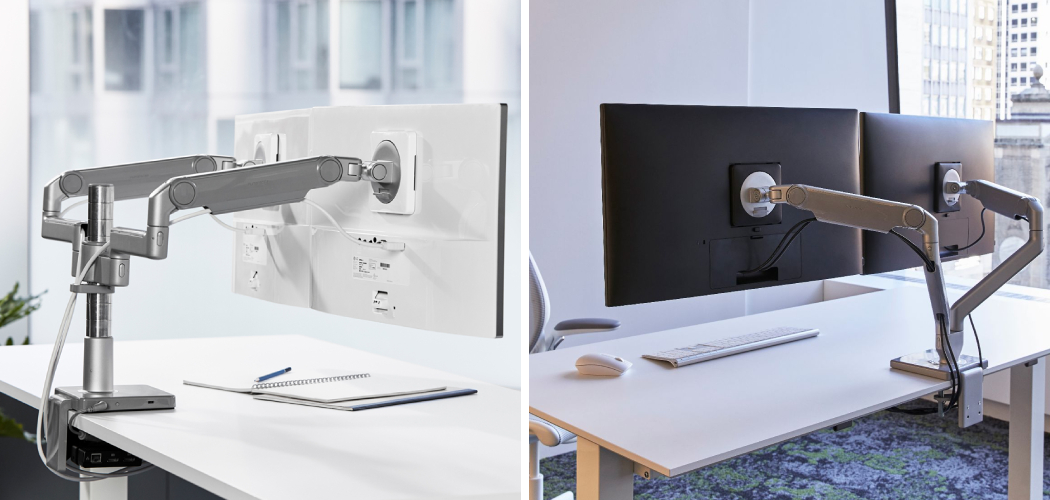Have you ever been in the middle of a Zoom meeting and noticed your laptop screen was too low on your desk, hindering visibility? Or perhaps you had to squint while reading emails because screens are close to your face.

Wouldn’t it be great if there was an easier way to raise, lower, and adjust your monitor arm height without having to stop what you’re doing? Well, look no further!
In this blog post, we will teach you how to adjust Humanscale Monitor Arm for optimal ergonomic comfort with the right tools. Read on for our step-by-step instructions – everything from taking apart the monitor arm mechanism all the way up to adjusting it correctly according to your needs. With these simple steps, you’ll be able to adjust your monitor arm quickly and effortlessly.
Supplies You Will Need to Adjust Humanscale Monitor Arm
- Humanscale Monitor Arm
- Allen Key or Screwdriver (depending on the model)
- User Manual
Step-by-step Guidelines on How to Adjust Humanscale Monitor Arm
Step 1: Understanding Your Humanscale Monitor Arm
Before making any adjustments, it’s crucial to familiarize yourself with your monitor arm. Generally, there are three types of monitor arms – A one-piece mount with no moving parts, a one-piece mount with a pivot joint, and a two-piece mount with an adjustable arm.
The Humanscale Monitor Arm falls into the third category. It consists of two pieces – an adjustable arm and a fixed mount. The fixed mount is attached to the desk, while the adjustable arm holds your monitor.
Step 2: Adjusting the Fixed Mount
The first step to adjusting your Humanscale Monitor Arm is to loosen the knob that attaches the fixed mount to your desk. Use an Allen Key or use a screwdriver (depending on your model) to turn the knob counterclockwise until it’s loose enough for you to slide the mount up or down. While adjusting, make sure the mount is securely fastened to your desk.

Step 3: Adjusting the Arm Height
Once you’ve adjusted the fixed mount, you can now focus on the arm height. Use the adjustment knob at the top of the arm to raise or lower it according to your comfort level.
You can also tilt and pivot your monitor as needed for optimal viewing. This feature is especially useful if you use multiple monitors, as you can easily adjust each one to your desired height and angle.
Step 4: Adjusting the Tension of the Arm
The Humanscale Monitor Arm also allows for tension adjustment, which controls how easily the arm moves. You can find this knob at the base of the arm where it meets the mount.
To increase the tension, turn the knob clockwise, and to decrease it, turn it counterclockwise. We recommend setting the tension at a level where you can easily move your monitor but still have enough resistance to hold it in place.
Step 5: Locking the Positions
Once you’ve made all necessary adjustments, make sure to lock the positions of both the fixed mount and the arm. This will ensure that your monitor stays in place and doesn’t move while you’re working. To lock the fixed mount, tighten the knob by turning it clockwise. To lock the arm position, use the tension adjustment knob to increase resistance when moving.

Following these simple steps, you can easily adjust your Humanscale Monitor Arm to achieve optimal ergonomic comfort. Remember to always consult the user manual for specific instructions on your model and make necessary adjustments according to your needs. With this knowledge, you can now say goodbye to neck and back pain caused by incorrect monitor positioning. Happy adjusting!
Additional Tips and Tricks to Adjust Humanscale Monitor Arm
1. Consider the weight of your monitor before adjusting the Humanscale Monitor Arm. The arm is designed to hold monitors weighing between 5 and 20 pounds. If your monitor falls outside this range, it may affect the arm’s ability to properly support and adjust your screen.
2. Use a level tool when installing the Humanscale Monitor Arm to ensure that it is straight and level. This will help prevent your monitor from tilting or drooping.
3. If you have a dual-monitor setup, make sure to evenly distribute the weight of both monitors on the arm. This will help maintain balance and prevent one monitor from moving more than the other.
4. Experiment with different arm adjustments to find the most comfortable and ergonomic position for your screen. Everyone’s needs and preferences are different, so take the time to find the best fit for you.
5. If your monitor is too high or low, consider using additional risers under the base of the arm to adjust its height. This will help prevent strain on your neck and shoulders.
6. Regularly check and tighten any bolts or screws on the Humanscale Monitor Arm to ensure it is secure and stable. This will prevent any accidents or damage to your monitor.
7. If you have trouble adjusting the arm, refer to the user manual for troubleshooting tips or contact Humanscale customer support for assistance.
8. Consider adding a monitor mount kit to your Humanscale Monitor Arm for additional flexibility and customization options.

9. Take breaks throughout the day to stretch and move around, even with a properly adjusted monitor arm. Sitting in one position for too long can still cause strain on your body and affect your overall health.
Following these tips and tricks will not only help you properly adjust your Humanscale Monitor Arm, but also create a more comfortable and healthy workspace. Remember to regularly reevaluate and readjust your monitor arm as needed to ensure it continues to meet your needs. Happy adjusting!
Precautions Need to Follow for Adjusting Humanscale Monitor Arm
- Before attempting to adjust your Humanscale monitor arm, make sure you thoroughly read the instruction manual provided with the arm.
- Ensure that you have all the necessary tools required for adjusting the monitor arm, such as a screwdriver or hex key.
- Make sure your monitor is turned off and unplugged before beginning any adjustments to avoid any potential electrical hazards.
- Be careful when handling the Humanscale monitor arm, as it may contain delicate components that can be damaged if handled roughly.
- If your Humanscale monitor arm has a gas spring, do not attempt to adjust it by force. Consult the instruction manual for proper adjustment techniques.
- If you are unsure about any step in the adjustment process, seek assistance from a trained professional or contact the manufacturer for further guidance.
- Do not make any adjustments while holding onto the monitor or any other part of the arm. This can cause instability and lead to injury or damage.
- Do not attempt to modify or repair the Humanscale monitor arm yourself, as this may void any warranties or damage the product.
Following these precautions will ensure a safe and successful adjustment of your Humanscale monitor arm. Now, let’s discuss some tips for adjusting the different components of the arm.
Frequently Asked Questions
What is a Humanscale Monitor Arm?
A Humanscale Monitor Arm is an ergonomic device that allows you to adjust your monitor’s height, depth, and angle for optimal viewing comfort.

Why Should I Use a Humanscale Monitor Arm?
Using a monitor arm helps reduce strain on your neck, back, and shoulders by allowing you to adjust your screen’s position to your eye level. This helps prevent common workplace injuries such as musculoskeletal disorders and eye strain. Additionally, it can improve your overall productivity and comfort while working at your desk.
Are There Any Limitations to Adjusting a Humanscale Monitor Arm?
While Humanscale Monitor Arms are designed to be highly adjustable, there are a few limitations to keep in mind. The weight capacity of the arm may limit the size and type of monitor it can support.
Additionally, some arms may have a limited range of motion or adjustability depending on their design. It’s important to carefully consider your specific needs and the capabilities of the monitor arm before making a purchase.
Can I Use a Humanscale Monitor Arm with Multiple Monitors?
Yes, some Humanscale Monitor Arms are designed to hold multiple monitors at once. These multi-monitor arms typically have a higher weight capacity and may offer additional adjustability options to accommodate the different screen sizes.
Conclusion
Congratulations! You now know how to adjust Humanscale monitor arm. This is an essential skill if you want to use this type of monitor stand for optimal ergonomic support. Not only can increasing the arm height help reduce shoulder and neck strain, but it can also improve visibility and access to your workspace, making your work easier and more efficient.
Now that you know the steps for adjusting your Humanscale monitor arm, get out there and configure it to fit your needs. With the right adjustments, you can make sure that your display is properly positioned for all your tasks at hand or, better yet, give yourself a well-deserved break by taking some time out in the sunshine—you deserve it!

